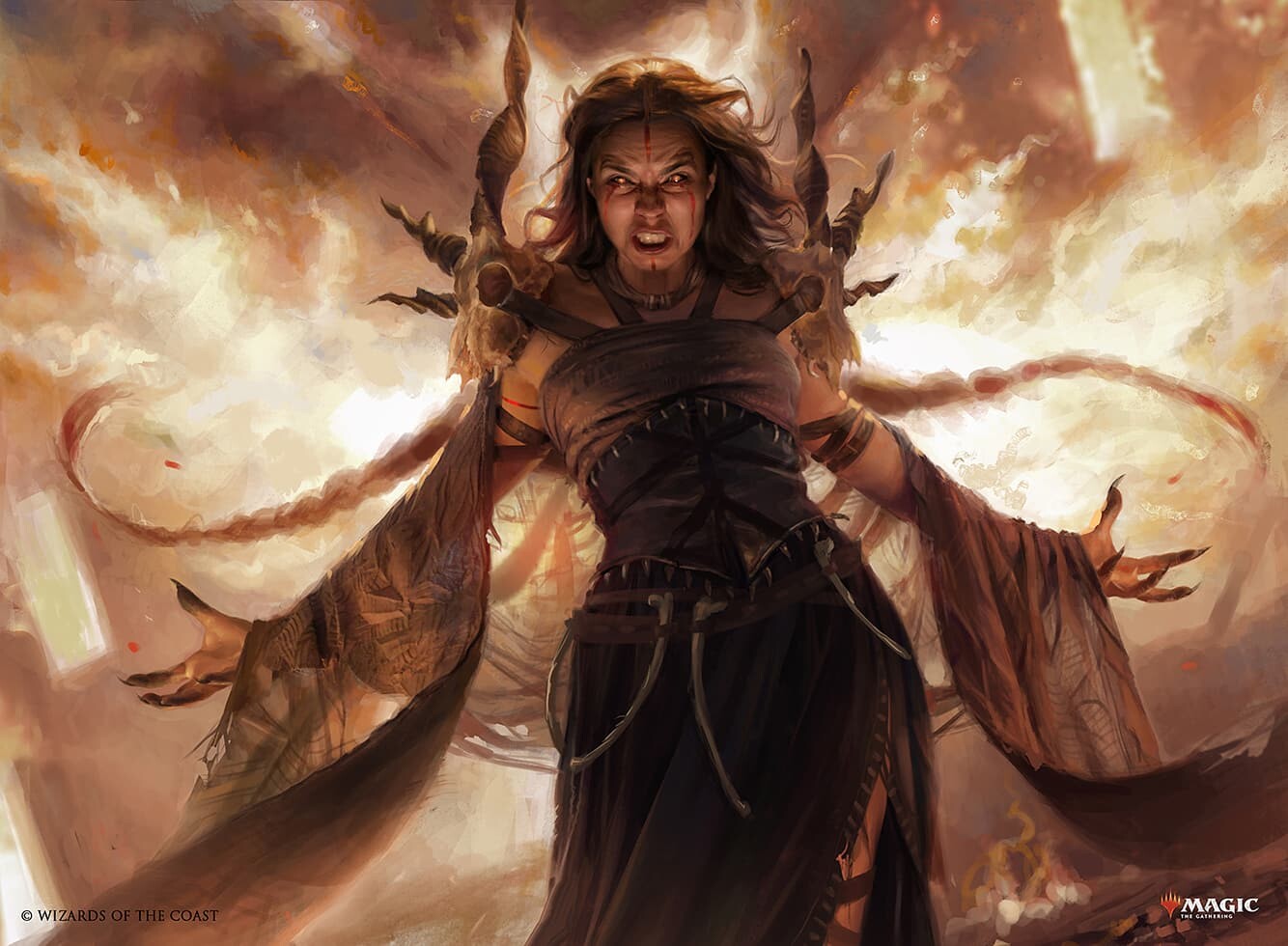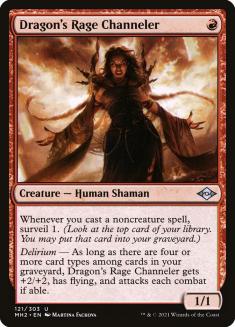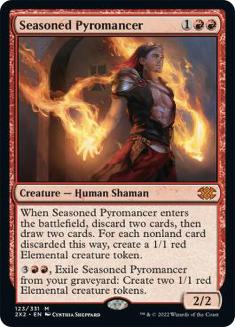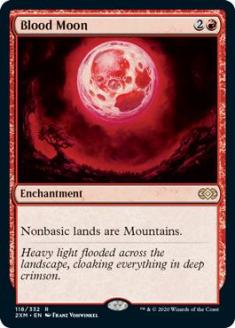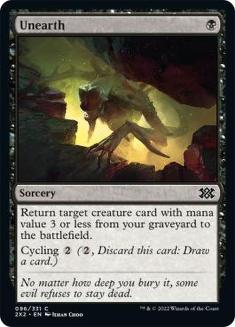It’s one of the five or ten most-played and most-decorated cards in Modern Horizons 2. Along with Ragavan, Nimble Pilferer and Unholy Heat, it has reshaped the landscape for midrange decks in Modern. And it also happens to play well with two of the other best cards in the format, Lurrus of the Dream-Den and Mishra’s Bauble. Of course I’m referring to Dragon’s Rage Channeler.
For the bargain-basement price of one red mana, you get a creature that is surprisingly easy to make a 3/3, provided your opponent isn’t going too far out of their way to mess with your graveyard. You also get a nice source of card selection that doesn’t cost you any additional mana. Costing zero mana is important because Modern has gotten so efficient, it’s hard to spend too much mana on smoothing out your draws or you’ll fall behind, especially in the early-game (hence why Mishra’s Bauble has become the premier cantrip in the format).
In addition to the card selection, surveil also has the potential to effectively generate card advantage by milling something like Kroxa, Titan of Death’s Hunger or Lava Dart. So for a low investment, you’re getting a card that can create quite a bit of value, which is the best of both worlds: low cost and high upside. So it’s no surprise that we see Dragon’s Rage Channeler in a range of archetypes, from the aforementioned midrange strategies to Prowess decks to Izzet Breach.
But for all its success and ubiquity in Modern, I believe Dragon’s Rage Channeler to be overrated in the current metagame. It’s a victim of its own success, as now players want to put it in nearly any red deck with Mishra’s Bauble, even shoehorning Bauble into a deck that otherwise wouldn’t be interested in order to make Channeler playable. Similarly, they are loath to cut it from decks it’s already in because of its pedigree.
Today I’ll dive into the metagame shifts that have led to Channeler’s current predicament and potential ways to retool some decks it currently appears in to be better adapted to the current Modern metagame.
How Did We Get Here?
Over the last month, Modern has finally started to slow down and coalesce around the most powerful strategies bolstered by Modern Horizons 2. Decks like Grixis Death’s Shadow (Lurrus), Mono-White Hammer (Lurrus), and Four-Color Midrange have been at the top of the metagame for weeks now, with a large population of Tier 2 strategies which regularly pop up in Top 8s but aren’t as ubiquitous as those three.
This shift from the dynamic metagame where the best deck would change each week to the current more stable one is the key variable in all of this. As the metagame slows down, it necessarily narrows around the most powerful and efficient decks, thereby making it rather difficult to play linear aggressive or combo strategies.
I’m sure you’re all familiar with the mantra that aggro decks are better-positioned early on in a metagame. After a rotation or a new set release, Standard tournaments would always be awash with Mono-Red and other aggro decks from players trying to take advantage of opponents who were playing with lots of new cards and didn’t have the time to properly tune their deck.
But over the coming weeks, they eventually do tune that deck, and either stick with it if it proves viable for the long term or abandon it for something better. If enough players do that, eventually there are no untuned decks to take advantage of. Those same aggressive decks lose part of the edge they had, and their popularity and success both decline.
This phenomenon essentially took hold in Modern with the release of Modern Horizons 2. The set has been so impactful, it essentially served as a point of rotation for the format without literally taking any cards out of the card pool. The early days after its release saw a rise in Amulet Titan, Izzet Prowess, and Asmor-based Food decks, all decks focused on executing their own gameplan and overpowering their opponents with limited interaction.
In this more open metagame with plenty of linear strategies, the midrange decks needed to be more aggressive, because they couldn’t rely on disruption to take over games against every deck. It also helped to beat untuned decks with ruthless efficiency. This made Dragon’s Rage Channeler an attractive threat, since it scores highly on both of these metrics.
After all, on the surface Dragon’s Rage Channeler is a rather aggressive card. No one is interested in a Mons’s Goblin Raiders with some incidental surveilling attached, so you have to evaluate the card based on the notion that you’ll reliably have delirium, at which point it’s a 3/3 with evasion that has to attack each turn if able. That’s about the most aggressive a card can be, sacrificing your versatility for even more efficiency.
But just like a Standard environment a month after rotation, the Modern metagame has slowed down. The hive mind has had plenty of time to tune the midrange and control decks of the format, making it harder for linear strategies to succeed. In particular, the most popular midrange deck, Grixis Death’s Shadow, is a well-oiled machine with pressure, discard, removal, and counterspells — everything you could ever want to beat linear decks.
As the metagame has slowed down, the matchups between these midrange decks have become more important, and it’s in these matchups where Channeler’s lack of versatility is problematic. It doesn’t let you play defense while behind, and is easily answered on a one-for-one basis, often at even mana as well. The value gained via surveil is nice, but hardly game-breaking in a world of Lurrus and other robust sources of card advantage.
The value Channeler provides is in its efficiency, allowing its controller to get ahead on the battlefield. But midrange mirrors are filled to the brim with cheap interaction, leading to lots of resource trading in the early-game. In games like this, there isn’t much incentive to get ahead on development, since your opponent’s disruption will ensure they don’t fall too far behind. You’re better off setting up for the late-game by trying to generate card advantage, even at the expense of early-game position. Alternatively, you can aim to cast threats that your opponent’s disruption doesn’t line up against, and take an aggressive posture with them.
Dragon’s Rage Channeler offers neither of these benefits, and is thus often a liability. This is not to say it’s not a good card because it certainly is. But its current status belies its actual effectiveness given the current complexion of the metagame. And players are starting to take notice.
The Rise of Elvish Reclaimer
Creatures (13)
Planeswalkers (4)
Lands (24)
Spells (19)

Jund players have been the first to move away from Dragon’s Rage Channeler, with some of them adopting Elvish Reclaimer in its place. I wrote about this innovation last week, praising it as a step forward for the archetype since Reclaimer offers much more optionality, often survives cards like Wrenn and Six and Lightning Bolt that Channeler doesn’t, and plays incredibly well with the Wrenn + Urza’s Saga engine that forms the backbone of this deck’s attrition plan.
Unsurprisingly, players have been slow in adopting the new tech, with most Jund lists still opting for Channeler, but I expect that to change in the coming weeks as the late-game superiority of Elvish Reclaimer proves more valuable.
And I expect the other midrange decks to make similar innovations, lest they fall behind the metagame. Whether there are worthwhile innovations for Grixis Death’s Shadow or Izzet Midrange to make remains to be seen, but if you’re playing these decks this is the step you should be looking to take to stay ahead.
I have an innovation I like for one of the older midrange decks in the Modern Horizons 2 metagame, Rakdos Midrange, but it involves a controversial exclusion. Let’s take a look.
Another Midrange Innovation
With its smooth manabase and the addition of Dauthi Voidwalker, Rakdos Midrange is more aggressive than many other midrange decks. This has contributed to its relatively poor performance recently, so it behooves devotees of the archetype to make some changes. And there are two cards that I think could change the deck’s fortunes:
Seasoned Pyromancer is simply one of the best attrition threats in Modern. First, it provides card selection to replace what you lose from cutting Dragon’s Rage Channeler. And in a deck with cards like Thoughtseize and Blood Moon that can lose a lot of value going long, the selection Pyromancer provides is particularly valuable. Of course, as the game does drag on and hands empty, that selection turns into straight card advantage.
Moreover, the pile of bodies Pyromancer provides makes it difficult to answer cleanly with spot removal, especially since the Pyromancer itself comes back as two more Elementals. This combination of difficult-to-remove creatures and immediate value via card selection and card advantage is the exact combination you’re looking for to take over attrition-oriented matchups like midrange mirrors.
Blood Moon takes the opposite approach to midrange mirrors, but is no less effective. Rather than win the attrition battle outright, Blood Moon seeks to ignore that axis of exchange and simply lock the opponent out of casting most of their spells. Basic land counts aren’t that high right now, and with Ragavan, you can cast it as early as Turn 2.
Here’s the list I would suggest to take advantage of this powerful pair:
Creatures (17)
- 4 Seasoned Pyromancer
- 3 Kroxa, Titan of Death's Hunger
- 4 Ragavan, Nimble Pilferer
- 3 Dauthi Voidwalker
- 3 Fury
Lands (22)
Spells (21)

The biggest loss here is obviously Lurrus, but you gain a lot more individually powerful cards to help you win the long game in midrange mirrors. Seasoned Pyromancer is great with Kroxa, so I’m up to playing three copies in the maindeck, and Fury goes from a way to recoup early tempo against Hammer and other creature decks to a powerful Nekrataal effect once you can hardcast it.
The removal suite is flexible, and if you move away from Unholy Heat you can cut Bauble entirely. But I think Heat is worth the addition, since Bauble comes at a low opportunity cost and helps enable the escape on Kroxa.
Unearth is the most questionable card in the maindeck, since you don’t have many targets for it. But it’s excellent with Seasoned Pyromancer and comes with a relatively high floor since you can always cycle it or pitch it to a Pyromancer trigger if you need to. Otherwise it could be the fourth copy of Dauthi Voidwalker to maintain threat density.
You can also make this deck even more flush with removal and card advantage by replacing Voidwalker with Bonecrusher Giant. This makes you even less aggressive, but if your expected metagame is particularly low on linear strategies then that’s the direction you want to move in.
Losing Lurrus is a big deal, but so is the combination of Fury, Blood Moon, and Seasoned Pyromancer, and when it comes to midrange mirrors, you want to be the slightly bigger deck so that over time, your individual card power overwhelms theirs. Put another way, you want to be the deck that has the best topdecks. The plethora of cheap discard and removal in these matchups almost ensures that both players will have empty hands as you progress to the middle and late stages of the game.
I noted last week that the current Modern metagame is one about making small innovations in established archetypes, and in order to find the right innovations, we have to question what we think we know about the format. Because while this metagame may have emerged from the same one that let Dragon’s Rage Channeler rise to prominence, the current reality is quite different. Games are slower, and you need more powerful cards to break the stalemate.
It’s time we start thinking bigger than a 1/1 for one mana.

